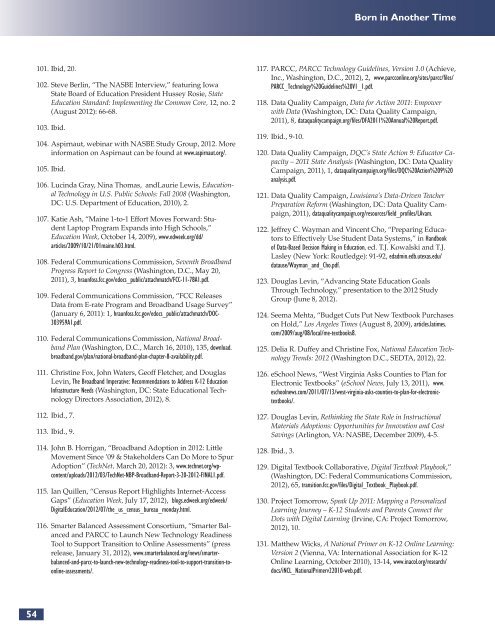Create successful ePaper yourself
Turn your PDF publications into a flip-book with our unique Google optimized e-Paper software.
54<br />
101. Ibid, 20.<br />
102. Steve Berlin, “The <strong>NASBE</strong> Interview,” featuring Iowa<br />
State Board of Education President Hussey Rosie, State<br />
Education Standard: Implementing the Common Core, 12, no. 2<br />
(August 2012): 66-68.<br />
103. Ibid.<br />
104. Aspirnaut, webinar with <strong>NASBE</strong> Study Group, 2012. More<br />
information on Aspirnaut can be found at www.aspirnaut.org/.<br />
105. Ibid.<br />
106. Lucinda Gray, Nina Thomas, andLaurie Lewis, Educational<br />
Technology in U.S. Public Schools: Fall 2008 (Washington,<br />
DC: U.S. Department of Education, 2010), 2.<br />
107. Katie Ash, “Maine 1-to-1 Effort Moves Forward: Student<br />
Laptop Program Expands into High Schools,”<br />
Education Week, October 14, 2009), www.edweek.org/dd/<br />
articles/2009/10/21/01maine.h03.html.<br />
108. Federal Communications Commission, Seventh Broadband<br />
Progress Report to Congress (Washington, D.C., May 20,<br />
2011), 3, hraunfoss.fcc.gov/edocs_public/attachmatch/FCC-11-78A1.pdf.<br />
109. Federal Communications Commission, “FCC Releases<br />
Data from E-rate Program and Broadband Usage Survey”<br />
(January 6, 2011): 1, hraunfoss.fcc.gov/edocs_public/attachmatch/DOC-<br />
303959A1.pdf.<br />
110. Federal Communications Commission, National Broadband<br />
Plan (Washington, D.C., March 16, 2010), 135, download.<br />
broadband.gov/plan/national-broadband-plan-chapter-8-availability.pdf.<br />
111. Christine Fox, John Waters, Geoff Fletcher, and Douglas<br />
Levin, The Broadband Imperative: Recommendations to Address K-12 Education<br />
Infrastructure Needs (Washington, DC: State Educational Technology<br />
Directors Association, 2012), 8.<br />
112. Ibid., 7.<br />
113. Ibid., 9.<br />
114. John B. Horrigan, “Broadband Adoption in 2012: Little<br />
Movement Since ’09 & Stakeholders Can Do More to Spur<br />
Adoption” (TechNet, March 20, 2012): 3, www.technet.org/wpcontent/uploads/2012/03/TechNet-NBP-Broadband-Report-3-20-2012-FINAL1.pdf.<br />
115. Ian Quillen, “Census Report Highlights Internet-Access<br />
Gaps” (Education Week, July 17, 2012), blogs.edweek.org/edweek/<br />
DigitalEducation/2012/07/the_us_census_bureau_monday.html.<br />
116. Smarter Balanced Assessment Consortium, “Smarter Balanced<br />
and PARCC to Launch New Technology Readiness<br />
Tool to Support Transition to Online Assessments” (press<br />
release, January 31, 2012), www.smarterbalanced.org/news/smarterbalanced-and-parcc-to-launch-new-technology-readiness-tool-to-support-transition-toonline-assessments/.<br />
Born in Another Time<br />
117. PARCC, PARCC Technology Guidelines, Version 1.0 (Achieve,<br />
Inc., Washington, D.C., 2012), 2, www.parcconline.org/sites/parcc/files/<br />
PARCC_Technology%20Guidelines%20V1_1.pdf.<br />
118. Data Quality Campaign, Data for Action 2011: Empower<br />
with Data (Washington, DC: Data Quality Campaign,<br />
2011), 8, dataqualitycampaign.org/files/DFA2011%20Annual%20Report.pdf.<br />
119. Ibid., 9-10.<br />
120. Data Quality Campaign, DQC’s State Action 9: Educator Capacity<br />
– 2011 State Analysis (Washington, DC: Data Quality<br />
Campaign, 2011), 1, dataqualitycampaign.org/files/DQC%20Action%209%20<br />
analysis.pdf.<br />
121. Data Quality Campaign, Louisiana’s Data-Driven Teacher<br />
Preparation Reform (Washington, DC: Data Quality Campaign,<br />
2011), dataqualitycampaign.org/resources/field_profiles/LAvam.<br />
122. Jeffrey C. Wayman and Vincent Cho, “Preparing Educators<br />
to Effectively Use Student Data Systems,” in Handbook<br />
of Data-Based Decision Making in Education, ed. T.J. Kowalski and T.J.<br />
Lasley (New York: Routledge): 91-92, edadmin.edb.utexas.edu/<br />
datause/Wayman_and_Cho.pdf.<br />
123. Douglas Levin, “Advancing State Education Goals<br />
Through Technology,” presentation to the 2012 Study<br />
Group (June 8, 2012).<br />
124. Seema Mehta, “Budget Cuts Put New Textbook Purchases<br />
on Hold,” Los Angeles Times (August 8, 2009), articles.latimes.<br />
com/2009/aug/08/local/me-textbooks8.<br />
125. Delia R. Duffey and Christine Fox, National Education Technology<br />
Trends: 2012 (Washington D.C., SEDTA, 2012), 22.<br />
126. eSchool News, “West Virginia Asks Counties to Plan for<br />
Electronic Textbooks” (eSchool News, July 13, 2011), www.<br />
eschoolnews.com/2011/07/13/west-virginia-asks-counties-to-plan-for-electronictextbooks/.<br />
127. Douglas Levin, Rethinking the State Role in Instructional<br />
Materials Adoptions: Opportunities for Innovation and Cost<br />
Savings (Arlington, VA: <strong>NASBE</strong>, December 2009), 4-5.<br />
128. Ibid., 3.<br />
129. Digital Textbook Collaborative, Digital Textbook Playbook,”<br />
(Washington, DC: Federal Communications Commission,<br />
2012), 65, transition.fcc.gov/files/Digital_Textbook_Playbook.pdf.<br />
130. Project Tomorrow, Speak Up 2011: Mapping a Personalized<br />
Learning Journey – K-12 Students and Parents Connect the<br />
Dots with Digital Learning (Irvine, CA: Project Tomorrow,<br />
2012), 10.<br />
131. Matthew Wicks, A National Primer on K-12 Online Learning:<br />
Version 2 (Vienna, VA: International Association for K-12<br />
Online Learning, October 2010), 13-14, www.inacol.org/research/<br />
docs/iNCL_NationalPrimerv22010-web.pdf.


